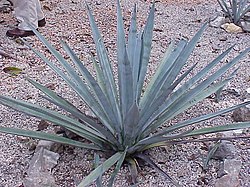Agave nectar
| Potentially edible! Food woo |
| Fabulous food! |
| Delectable diets! |
| Bodacious bods! |
Agave nectar (or agave syrup) is a sweetener made from plants in the genus Agave. Other uses of the agave plant include the production of tequila, which is fermented from the blue agave's sugary juices.
There are four camps related to the sweetener: The marketers who promote it as a "natural alternative" to sugar; the CAM users who hate it for being "unnatural" and processed; the people who know it's just sugar!; and those who know it's mostly sugar and way too expensive, but has a distinct flavor to it that makes it different from sugar in some culinary applications.
Criticism[edit]
Agave nectar is marketed as being somehow better and more natural than white sugar and high-fructose corn syrup, even though it actually contains more fructose than HFCS (agave nectar can contain anywhere from 55% to 90% fructose, while high-fructose corn syrup usually contains 42% to 55% fructose).[1][2][3] This can cause extreme distress in people with fructose malabsorption or similar conditions, with the side effect of being not as easily identifiable on a list of ingredients (the fructose content of agave nectar is not as obvious as a label listing "high-fructose corn syrup") or when encountered in prepared food as a "healthy" substitute.
Some[4][5] (including Joseph Mercola)[6] criticize it for not being natural (as though that actually mattered), and for having too much fructose (which is more reasonable). (Agave is indeed highly processed.)[7] The Weston A. Price Foundation condemns agave on the grounds that it contains saponins, which possibly cause miscarriage;[8] however, other plants that contain saponins include chickpeas, alfalfa sprouts, oats, beans, red onions, and potatoes.[9]
The rational perspective[edit]
It's just sugar. Besides being quite high in fructose, and having 50% more calories per tablespoon than table sugar, it is nutritionally essentially no better or worse than any other kind of added sugar.[7] Like honey or molasses, it has a richer taste profile, so it is a nice addition to teas, cereals, or anywhere you are looking for something more than just "sweet." Because no bugs are harmed in its production (tequila weevils, Scyphophorus acupunctatus, are probably killed) bees are not enslaved during production, it also makes a good vegan honey substitute.[Note 1] (Then again, so does high-fructose corn syrup, but for some reason the vegan community doesn't seem too fond of that.)
See also[edit]
Notes[edit]
- ↑ Never mind the agave-pollinating bats who starve because the plants end up as syrup before they can bloom. The bees are the only pollinators people care about.
References[edit]
- ↑ The Truth About Agave, WebMD.
- ↑ Not Enough Evidence to Indict High Fructose Corn Syrup in Obesity, University of Maryland.
- ↑ It's been called "High-Fructose Cactus Syrup" by its opponents.
- ↑ Is Agave Nectar Safe? Global Healing Center.
- ↑ Why I NEVER Use Agave, Real Food Forager.
- ↑ Agave: A Triumph of Marketing over Truth, Joseph Mercola, July 02, 2009.
- ↑ 7.0 7.1 Agave, WebMD.
- ↑ Agave Nectar: Worse Than We Thought, Sally Fallon Morell and Rami Nagel, The Weston A. Price Foundation.
- ↑ Is Agave Worse Than High Fructose Corn Syrup?, HowStuffWorks.
